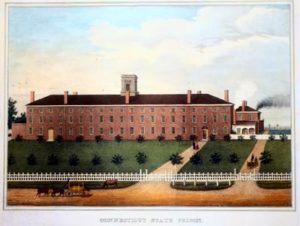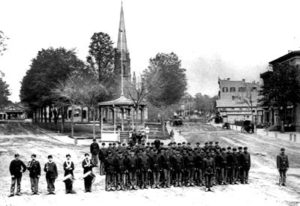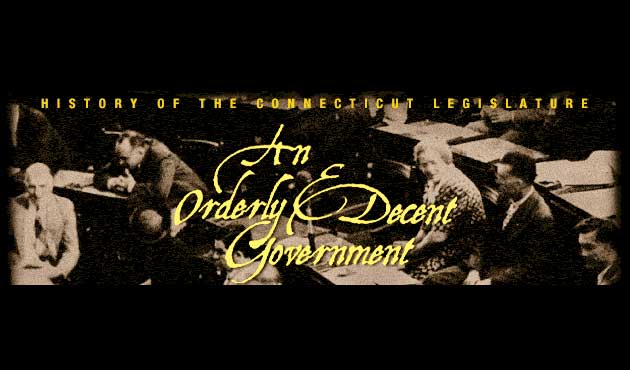A Rapidly Changing Society
Worried about declining trade, merchants urged the General Assembly to improve the state’s transportation system. Owners of toll roads fought in the legislature to retain their advantages, while canal builders and railroads lobbied to supplant them. The legislature balanced regional interests by chartering the Farmington Canal in 1822 to serve New Haven and the Windsor Locks Canal in 1824 to benefit Hartford interests.

The State Prison at Wethersfield
The General Assembly was slow to deal with rising crime, poverty and the other social costs of a rapidly changing society. In 1827, the General Assembly authorized the construction of a state-of-the art prison in Wethersfield. Considered a model of humanitarian reform in its day, it included workshops run by human-powered treadmills.
Reforming Education
Connecticut’s once proud education system declined steadily in the early 1800s. Between 1820 and 1839, the General Assembly provided no funding for local education.
“The common school should no longer be regarded as “common” because it is cheap, inferior, and attended only by the poor and those who are indifferent to the education of their children, but “common” as the light and the air because its blessings are open to all and enjoyed by all. That day will come.”
– Henry Barnard, 1838
Canals were eclipsed in the 1840s by the more efficient railroad, but unsafe conditions and careless operations made deadly accidents a common occurrence. In 1853, the General Assembly established the State Railroad Commission to inspect railroads and investigate accidents.

A train wreck in South Norwalk, May 6, 1853, killed 45 people.
In 1838, the legislature created a Board of Commissioners of the Common Schools, the forerunner of the Department of Education, to reform Connecticut’s common schools. Under former legislator Henry Barnard‘s leadership, Connecticut’s schools became a national model.
An Uproar of Causes
By the 1850s, Connecticut’s politics grew increasingly chaotic. Democrats and Whigs contended with small, single issue parties advocating such causes as the abolition of slavery, prohibition of alcohol and the repression of immigrants. Repeatedly, the Assembly had to elect a governor by joint ballot when no candidate in the multi-party statewide election won a majority.

Civil War soldiers mustering
By 1858, limiting the expansion of slavery nationally had become an overriding political issue for most Connecticut residents. Calling themselves the Republicans, a new political party rose above the fragmented politics of the 1850s and took control of the General Assembly.
During the Civil War, Connecticut sent over 55,000 troops to help the Union cause. More than 20,000 suffered casualties and 5,478 were killed. The General Assembly outfitted 36 regiments, including Irish and African-American units, and Connecticut’s industries produced guns, bayonets, boots, supply wagons, uniforms, buttons, and ironclad warships for the war effort.
This article is a panel reproduction from An Orderly and Decent Government, an exhibition on the history of representative government in Connecticut developed by Connecticut Humanities and put on display in the Capitol concourse of the Legislative Office Building, Hartford, Connecticut.
<< Previous – Home – Next >>








